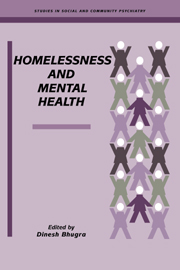Book contents
- Frontmatter
- Contents
- List of contributors
- Preface
- Part I INTRODCTION AND SPECIAL GROUPS
- Part II SERVICES
- 7 Services for the mentally ill homeless
- 8 Clinical work with homeless people in the USA
- 9 The severely mentally ill in hostels for the homeless
- 10 Old and homeless in London and New York City: a cross-national comparison
- 11 Primary health care of the single homeless
- Part III INTERNATIONAL PERSPECTIVE
- Part IV POLICY AND EVALUATION
- Index
10 - Old and homeless in London and New York City: a cross-national comparison
from Part II - SERVICES
Published online by Cambridge University Press: 15 October 2009
- Frontmatter
- Contents
- List of contributors
- Preface
- Part I INTRODCTION AND SPECIAL GROUPS
- Part II SERVICES
- 7 Services for the mentally ill homeless
- 8 Clinical work with homeless people in the USA
- 9 The severely mentally ill in hostels for the homeless
- 10 Old and homeless in London and New York City: a cross-national comparison
- 11 Primary health care of the single homeless
- Part III INTERNATIONAL PERSPECTIVE
- Part IV POLICY AND EVALUATION
- Index
Summary
Introduction
Persons aged 50 and over are estimated to comprise about one fifth of the homeless in New York City (NYC) and nearly one third of the homeless in London (Weeden & Hall, 1985; Kelling, 1991). The proportion of those aged 50 and over living in substandard singleroom occupancy (SRO) hotels or hostels may be even higher (Keigher, 1991). However, older homeless have been an unwanted stepchild of both the fields of homelessness and geriatrics. In contrast to the scholarly literature on younger homeless that has mushroomed in recent years, there have been relatively few papers written about ageing homeless (Cohen, 1996). On a service level, most senior citizen centres have shown little interest in this group, and public shelters have been typically avoided by older homeless persons because of fear of aggression by younger homeless, insensitive staff and accommodations that are not suitable for their physical disabilities (Coalition for the Homeless, 1984). Finally, governmental policy has failed to recognize the special needs of this ageing group, and even when statutory entitlements exist, many older homeless have not obtained such benefits (Kelling, 1991; Crane, 1993).
Although the absolute numbers of homeless persons in London are lower than in NYC, the former has the highest number of homeless persons among Western European cities (Adams, 1986; Toro & Rojansky, 1990; Schmidt, 1992). This commonality of large-scale homelessness in both cities creates an opportunity to undertake cross-national comparisons of ageing homeless. Such comparisons can provide answers to: (a) the proportionate contribution to the causes of homelessness of individual pathology and behaviour versus socio-political (structural) forces;
- Type
- Chapter
- Information
- Homelessness and Mental Health , pp. 150 - 169Publisher: Cambridge University PressPrint publication year: 1996
- 8
- Cited by



